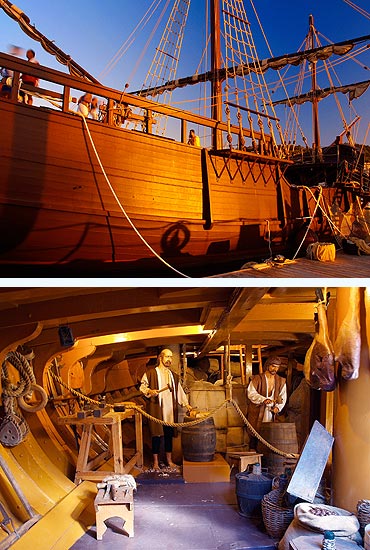
Baiona was the first port in Europe to know about the discovery of America. On March 1st, 1493, Caravel La Pinta, commanded by Martín Alonso Pinzón, arrived in this port. For the 5th Centenary of the Discovery commemorations a replica of the ship was built. The replica is moored in a dock in the bay and it can be visited.
In 1999 the small museum inside the caravel was reorganised and enriched with all the items belonging to the Columbian times -from Christian to Taino cultures. This way, visitors know the Caravel as it arrived to Baiona in 1493 and bring back to life the Discovery deed: dummies looking like the crew and native Americans aside by side with reproductions of metals, plants, food and exotic animals found in the New World.
Information about this kind of ship is very little. Its name comes from the Arabic term "carabo". The Portuguese brought it from the East and they also added the lateen sail (triangular).
During early 15th century just Portugal and Spain sailed in caravels, and so they improved the design. In Spain the Andalusian caravel was built: narrower hull, bastard mirror stern, front and poop decks and, instead of the lateen sail, a round-shaped sail better profiting from winds. Besides, the centre of gravity was lowered and, as a consequence, the ship was more stable.
Caravel stood out from vessels because they were smaller and lighter and they lacked castle, top, bowsprit sail and topsail.
Shipyard carpenters in Palos de la Frontera built it; it belonged to Cristóbal Quintero y Gómez Rascón, local shipowners from whom the ship was confiscated. It was named after its former owners, the Pinto family, also from Palos. La Pinta was the quickest of the three Columbian ships: during the historic voyage she usually had to wait for the other two, partly thanks to Captain Pinzon's good command. On October 8th, in the struggle to be the first in sighting new land, it reached 15 miles per hour (the equivalent to present times 12 miles/hour, a speed higher than the speed a medium-size steam merchant ship can reach today.
Corn, yuca or manioc, batata or age, beans and peanuts.
Chilli and cinnamon.
Cotton and maguey.
Mastic, michoacan, jalap and tobacco.
Bija and jagua.
There was a huge variety in those islands. Columbus described them with the European names given to similar species; thus, they are quite difficult to identify. Some pieces of fruit were brought dried to avoid rotting during the way back.
The caravels brought samples of different tree kinds fousn in the islands of Cuba and La Española, among which there were hicaco, mangrove, ceiba and mahogany.
After considering the difficulties in transportation and the minimum surviving chances, just a few exotic animals were brought and only a few parrots arrived alive. Some other animals were brought skinned or in brine: a boxfish, an iguana -with highly appreciated meat and eggs for natives-, brined skins of cori (guinea pig) and hutia or jutia.
Apart from those products made of gold and cotton, the expedition brought back masks made of fish bones, called guayças, belts, rubber balls made of a resin mixture, assegais (light javelins)), canoes, hammocks, pumpkins, bows and arrows.